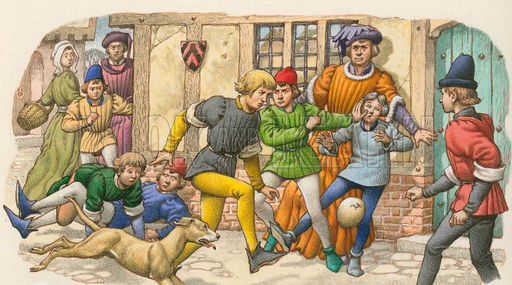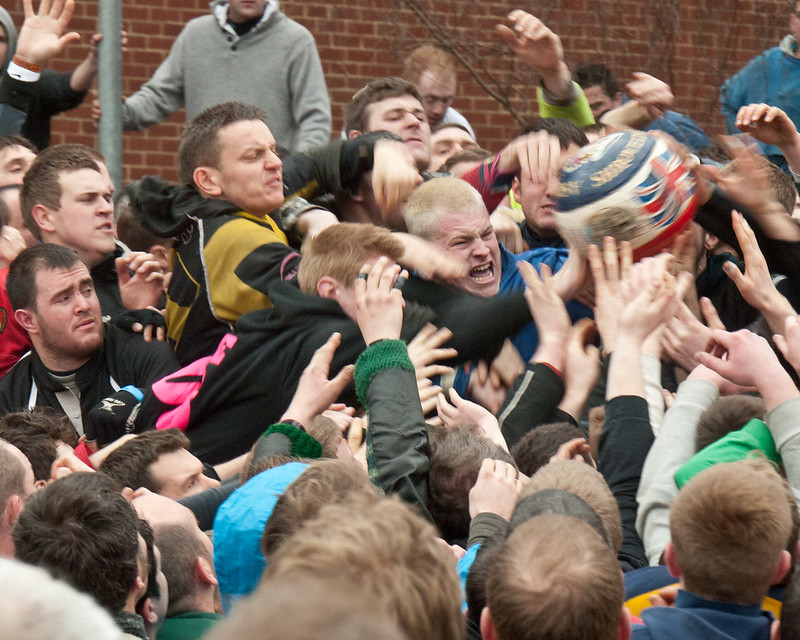Rooted in medieval traditions, the origins of mob football – aka medieval football, folk football – can be traced back to various forms of folk games played in England during the Middle Ages, particularly from the 12th to the 16th centuries. These games were characterized by their unstructured nature and lack of standardized rules, allowing entire communities to engage in spirited contests. Villagers often gathered, sometimes divided by geographical boundaries, to compete for possession of a ball made from animal bladders or rags.

Gameplay was marked by chaotic and often violent interactions, reflecting the communal spirit of the time. This form of football served not only as entertainment but also as a means of social cohesion, fostering a sense of identity among participants. The objective focused less on scoring goals and more on the exhilaration of competition itself, embodying the desire for freedom and expression essential to these early contests.
As these folk games evolved, they laid the groundwork for modern football, influencing its development while retaining the essence of community and collective participation. The legacy of mob football endures, reminding us of a time when sport was an unrestrained celebration of human spirit and camaraderie.
The Rules of Chaos
The chaotic nature of mob football is governed by a loose set of rules that dictate the game’s objectives, player conduct, and duration. The primary aim is to score by getting the ball into the opposing team’s goal, but the absence of formal regulations leads to unpredictable behavior among players. Understanding these guidelines helps appreciate how the game’s spirit thrives amidst its inherent disorder, especially since its origins can be traced back to the 12th century.
Objective of the Game
In mob football, the main objective is the chaotic pursuit of a spherical ball, with teams competing to score by sending it into their opponent’s goal. This unstructured game, which dates back to the 12th century, invites spontaneity, allowing players to roam the field with minimal restrictions. The excitement lies not only in scoring but also in the unpredictable nature of play, showcasing a deep-rooted desire for freedom and self-expression.
The following table outlines the key elements that define the objective of mob football:
| Element | Description |
|---|---|
| Goal | Score by getting the ball into the opponent’s goal |
| Teams | Often large, with varying numbers of players |
| Field | Open terrain, usually defined by natural boundaries |
| Ball | A spherical object, often made of leather or similar material |
| Strategy | Fluid and adaptable, prioritizing creativity over structure |
As players engage in this wild contest, the essence of mob football lies in the shared pursuit of exhilaration, camaraderie, and the unyielding spirit of competition. The game emphasizes the joy derived from the chaos that unfolds on the field.
Player Conduct Guidelines
In the exhilarating chaos of mob football, player conduct guidelines ensure some order amidst the unpredictability. These principles, established over time, are vital for preserving the spirit of the game while promoting respect and responsibility.
Key conduct expectations for players include:
- Respect opponents: Embrace competition without engaging in malicious actions.
- Foster camaraderie: Promote teamwork and unity, even in the midst of chaos.
- Prioritize safety: Play spiritedly while ensuring the well-being of all participants.
- Maintain sportsmanship: Celebrate victories with grace and accept defeats with dignity.
- Adaptability: Embrace the game’s unpredictable nature and adjust strategies as needed.
Game Duration and Scoring
Unlike conventional sports with fixed time limits, mob football often lasts until a specific goal is achieved or until players tire out. This dynamic nature encourages a sense of freedom among participants as they vie for control of the field.
Scoring in mob football is as varied as the game itself. Teams typically aim to move a ball to a designated area, which may be marked by a landmark or goalpost, to earn points. However, scoring criteria can differ significantly among regions and groups, resulting in a wide range of scoring methods. Goals can be accomplished through brute force, strategic play, or even unexpected partnerships formed during the matches.
Medieval Ball Games: A Lingering Legacy
Medieval ball games have stood the test of time, evolving into unique local traditions that continue to be celebrated across England and Scotland. These games, steeped in history, often coincide with significant events in the Christian calendar and showcase the communal spirit of the regions in which they are played.
In England, one of the most notable surviving games is the Bottle-Kicking in Hallaton, Leicestershire. Celebrated on Easter Monday, this spirited contest involves players competing to kick three wooden barrels across a field, embodying the raucous nature of medieval festivities. Similarly, Scoring the Hales in Alnwick, Northumberland, begins with a dramatic drop of a ball from Alnwick Castle’s battlements, marking a tradition that intertwines royalty with the community’s heritage.
The Royal Shrovetide Football of Ashbourne, Derbyshire, and the Atherstone Ball Game in Warwickshire also capture the essence of medieval sportsmanship. The latter, dating back over 800 years, is played along an ancient Roman road, showcasing a rich historical tapestry dating back to King John’s reign. Not to be overlooked, the Shrove Tuesday Football Ceremony of Corfe Castle and the Haxey Hood in Lincolnshire, where players strive to maneuver a leather tube to local pubs, offer a glimpse into the unique local customs that have persisted through the ages.

In the west of England, Hurling the Silver Ball in St Columb Major, Cornwall, pits town against country in a match steeped in tradition, while Workington’s Uppies and Downies matches in Cumbria exemplify the sheer unpredictability and raw physicality of medieval sport, with no rules to govern the chaos.
Across the border in Scotland, the Ba’ Game remains a beloved tradition, with variations played in places like Duns, Jedburgh, and Kirkwall. Each locality brings its own flavor to the game, ensuring that the spirit of medieval ball games lives on, vibrant and full of life.
Together, these surviving medieval ball games not only celebrate athleticism and community but also serve as a testament to the rich cultural heritage that has endured through centuries, connecting generations through the joy of play.
Variations Across Regions
Mob football, a game with deep historical roots, exhibits a fascinating array of regional variations influenced by local customs and cultures. In England, the game gained popularity in the 12th century, often involving entire villages competing against one another with minimal rules and an emphasis on chaos, particularly during festivals.
In contrast, Calcio Storico emerged in Florence, Italy, in the 16th century, blending elements of soccer, rugby, and wrestling. This variant is characterized by its formalized rules and strong neighborhood representation, reflecting local identity.
Meanwhile, in France, a similar game called “La Soule” was played, especially in Normandy and Brittany regions, where players aimed to kick a ball to designated markers. This variation, which dates back to the Middle Ages, placed a greater emphasis on strategy and teamwork compared to the more anarchic English style.
These regional adaptations of mob football underscore the diverse interpretations of communal play, with each version mirroring the unique cultural fabric of its society. Ultimately, mob football remains a celebration of freedom, competition, and local tradition.
Transition to Organized Soccer
The evolution towards organized soccer represents a remarkable transformation in both the gameplay and societal perception of the sport. With rudimentary rules and the participation of entire towns, these early matches prioritized community rivalry and physical prowess over skill and strategy, frequently resulting in injuries and property damage.
As the 19th century approached, the need for a more structured approach to the game became apparent. The establishment of schools and universities in England played a crucial role in this transition, as different institutions developed their own variations of the sport. This diversity led to the call for standardized rules, culminating in the formation of the Football Association (FA) in 1863. This pivotal moment established the first official regulations for the game, clearly distinguishing it from rugby and laying the groundwork for a more organized framework.
The introduction of standardized rules significantly enhanced the game’s appeal, allowing for defined positions and team sizes, which fostered a sense of identity and pride within communities. The formation of leagues and competitions not only promoted healthy competition but also encouraged camaraderie among players.
Moreover, organized soccer democratized the game, opening avenues for broader participation regardless of age or gender. This shift from the chaotic nature of mob football to a structured format not only redefined how the sport was played but also reinforced its role as a unifying force, transcending social barriers and celebrating the freedom of play. As communities embraced organized soccer, they recognized it not just as a game, but as an essential part of their cultural identity and social fabric.

